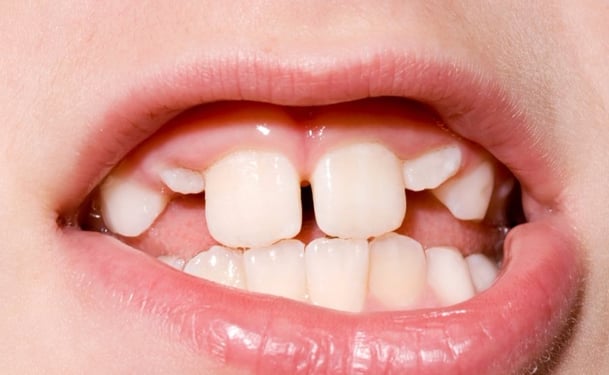A perfect smile should have every tooth in place. However, that's not always the way it works out. Crowding and overlap can occur. If this sounds like your mouth, consider one of the following options:
Braces
Braces work by putting pressure on your teeth to shift them into a more attractive position. Ask your dentist for referral to an orthodontist, who can discuss which of the many types of braces is right for you. Often, braces come in the form of metal, plastic or ceramic brackets glued to the front of the teeth. These brackets hold a tightening wire in place. The wire is in the shape your orthodontist wants to see your teeth. Once threaded through the brackets, this wire tries to get shift into shape, and moves your teeth along with it. These wires are tightened once a month for a period of up to two and a half years, depending on the severity of your condition. Of these three types of braces, ceramic brackets are the least noticeable, as their translucent colour allows them to blend in with the natural teeth colour. Lingual braces are a similar, even less visible option—the brackets are glued to the back of your teeth. Once the braces come off, you will likely have to wear a retainer for a few months to keep your teeth from shifting. Note that orthodontists will sometimes request that teeth be pulled in order to create room for the newly-straightened teeth to sit into.
Invisalign
A newer and costlier option is Invisalign, a series of plastic, transparent, removable aligners that squeeze the teeth tightly into place. Like braces, Invisalign shifts your teeth into a straighter position. Note that Invisalign might not work for more complex overlaps. Ask your dentist if this option will work for you.
Contouring and Reshaping
If you have a slight overlap, your dentist can use the contouring and reshaping procedure to narrow the teeth that overlap the others. Your dentist will use a drill or laser to remove a small amount of enamel. Next, he or she will use abrasive strips to "sculpt" your tooth into a more attractive shape. Removing large amounts of enamel may ultimately weaken the teeth, so it is best for this procedure to be combined with porcelain veneers or bonding to minimize the amount of enamel removed.
Bonding
Your dentist can correct overlaps in your teeth by applying plastic resin bonding to the surface of your teeth. After grinding away part of your enamel, your dentist applies phosphoric acid. The acid creates tiny crevices in the tooth into which the resin sticks. Next, your dentist shapes the resin into the desired form. This is the stage where the resin is molded into such a way that straightens previous overlaps. He or she flashes a light on the tooth to harden the resin. A polish finishes the process.
Porcelain Veneers
Porcelain veneers, thin ceramic casings fitted onto the tooth, can give you an all-new, natural looking smile. A cosmetic dentist will shave off part of your tooth enamel to create space for the casing. At this stage, he or she can sculpt your existing teeth in such a way that the overlaps are corrected. Your cosmetic dentist will create a mold based on the sculpted teeth, and send this mold off to the lab where your custom-made veneers will be created. Once your veneers are ready, your dentist will cement them to your teeth. Your smile will be straighter and, depending on the shade you choose for your new smile, whiter.
Note: Your dentist will often recommend a combination of treatments to achieve the look you desire. Often, these treatments may include the extraction of one or more teeth to make room for the straightened teeth.
-
Treatments & Info
- Articles
- BOTOX
- Braces
- Bridges
- Brite Smile Teeth Whitening
- Cosmetic Dentistry
- Cosmetic Gum Surgery
- Cosmetic Laser Dentistry
- Crowns
- da Vinci Veneers
- Dental Articles
- Dental Bonding
- Dental Crowns
- Dental Fillings
- Dental Implants
- Dental Inlay
- Dental Veneers
- Dentistry
- Denture Creams
- Dentures
- General Dentistry
- Invisalign
- Laser Dentistry
- Laser Teeth Whitening
- LUMINEERS by Cerinate
- Orthodontics
- Pediatric Dentistry
- Porcelain Crown
- Porcelain Veneers
- Retainers
- Root Canals
- Smile Makeover
- Teeth Straightening
- Teeth Whitening
- Tooth Extraction
- Wisdom Tooth Extraction
- Zoom Teeth Whitening
- Find a Dentist
- Ask a Doctor
- Before & After


